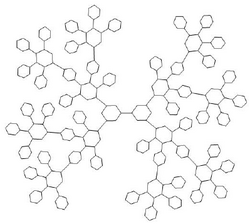Padmakar–Ivan index
In chemical graph theory, the Padmakar–Ivan (PI) index is a topological index of a molecule, used in biochemistry. The Padmakar–Ivan index is a generalization introduced by Padmakar V. Khadikar and Iván Gutman[1] of the concept of the Wiener index, introduced by Harry Wiener. The Padmakar–Ivan index of a graph G is the sum over all edges uv of G of number of edges which are not equidistant from u and v. Let G be a graph and e = uv an edge of G. Here [math]\displaystyle{ n_{eu}(e\mid G) }[/math] denotes the number of edges lying closer to the vertex u than the vertex v, and [math]\displaystyle{ n_{ev}(e\mid G) }[/math] is the number of edges lying closer to the vertex v than the vertex u. The Padmakar–Ivan index of a graph G is defined as
- [math]\displaystyle{ \operatorname{PI}(G)=\sum_{e\in E(G)}[n_{eu}(e\mid G) + n_{ev}(e\mid G)] }[/math]
The PI index is very important in the study of quantitative structure–activity relationship for the classification models used in the chemical, biological sciences, engineering, and nanotechnology.
Examples
The PI index of Dendrimer Nanostar of the following figure can be calculated by[2]
- [math]\displaystyle{ \operatorname{PI}(G_n) = 441\cdot4^n - 639\cdot2^n + 232, \quad n \geq 0. }[/math]
References
- ↑ Padmakar, V. Khadikar.; Sneha, Karmarkar; Vijay K., Agrawal (2001), "A Novel PI Index and Its Applications to QSPR/QSAR Studies", J. Chem. Inf. Comput. Sci. 41 (4): 934–949, doi:10.1021/ci0003092, PMID 11500110.
- ↑ Khalifeh, M.H.; Darafsheh, M.R; Jolany, H. (2011), "The Wiener, Szeged, and PI Indices of a Dendrimer Nanostar", Journal of Computational and Theoretical Nanoscience 8 (2): 220–223, doi:10.1166/jctn.2011.1681, Bibcode: 2011JCTN....8..220K.
 |


